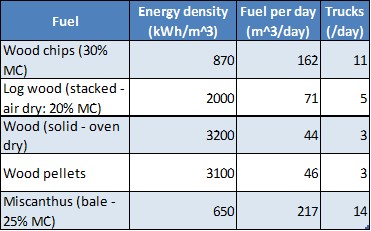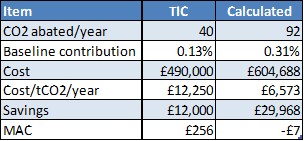Supply Options
Building on the carbon reductions achieved through demand reduction, it is necessary to decarbonise energy supply on campus to meet the 50% CO2 reduction target by 2030. A number of options are available. For the purposes of this project, the following low carbon supply options were considered:
• District heating network
• Combined heat and power (CHP)
• Heat pumps
• Biomass
• Solar photovoltaics (PV’s)
• Wind turbines
Similar to the demand reduction scoping criteria, the following criteria were used to decide which options were the most promising for inner city campuses:
• Capital cost
• Financial savings
• Carbon savings
• Payback period
• £/tCO2 per annum
• Marginal Abatement Cost (MAC)
• Technical and environmental considerations
Based on the above criteria, certain technologies like Biomass, Solar PV and wind turbines have been scoped out. The reasoning behind it is as stated below.
Biomass
One of the key reasons that biomass was scoped out as a low carbon heat supply is that to meet the average daily heat demand of the case study (approximately 141 MWh) there would have to be between 3 and 11 trucks of fuel per day delivered to the campus (Table a). This would be disruptive for inner city campuses and surrounding traffic so would be logistically unattractive.

There is also the issue of the storage space needed to store 44-217m3 of fuel per day. Biomass has a low energy density so needs large volumes of space, something that is in short supply in an inner city campus.
In terms of making a contribution to heating supply, if biomass was used to supply a third or less of the universities heat demand the issues of storage and delivery are reduced but not solved. Also, the figures presented above represent an average heating day. Peak days can have 3-5 times the energy requirements.
Aside from space and logistical issues, there is the added complication of air quality concerns. Burning biomass produces particulate matter and nitrous oxides locally. Within city limits, where air quality standards are stricter, this would require a tall enough flue chimney with scrubbers and filters to mitigate against the effects of the local pollution (Forestry Commission & BEC, 2010). This adds cost and complication to the installation and operation of the biomass plant.
For the reasons stated above, biomass was scoped out of the project as the group decided that it does not seem a sensible solution to decarbonisation at this time. In addition it is unlikely that there will be enough land to grow enough biomass in order to meet the heat demand for all universities across the UK (JNCC, 2011). Therefore, in order to produce a general strategy for campus carbon emission reduction (as per the project aims), biomass cannot sustainably contribute to carbon reduction at this time.
Solar Photovoltaics
Solar photovoltaic (PV) panels can decarbonise electricity supply by renewably producing electricity which displaces electricity that would otherwise be imported from the national grid. As a carbon abatement technology for an inner city university campus, particularly in Scotland, they are unattractive for two main reasons: low MAC and poor contribution to baseline carbon emission reduction (outlined in Table b).

It is unlikely at this time that solar PV can make any significant contribution to offsetting carbon in energy dense areas like inner city campuses (especially in areas with lower solar insolation, like Scotland). There is limited roof space and therefore limited generation potential. This is demonstrated in Table b by the 0.13-0.31% contribution to carbon baseline emission reduction from the PV panels. Even if these estimates are low, they are unlikely to vary in the orders of magnitude necessary to make any difference.
For these reasons solar PV panels were scoped out of the project.
Wind Turbines
Considering that our strategy is only focused on on-site measures, it would be almost impossible to accommodate large scale wind turbines in the city, due to unavailability of open space. Another realistic possibility would be to integrate wind turbines into existing structures and buildings in and around the campus.
In a fairly open space or a rural environment, large wind turbines are usually located at least 500 metres from human dwellings making energy capture very viable. However in the case of wind turbines in a city environment, if positioned on buildings, would present the hazard of rotating machinery, vibrational dynamic loading, noise generation and a potential risk of collapse. In addition to that, there is a high degree of turbulence, necessitating frequent repairs and non-optimal wind conditions due to presence of building structures and trees (Ragheb, 2014).
For these reasons, wind turbines were scoped out as a carbon abatement technology.
Summary
After biomass, PV panels and wind turbines were scoped out, a District Energy Network (DEN) was investigated. The technologies considered to power the DEN were Combined Heat & Power (CHP) and large scale heat pumps alongside peak load gas boilers. For the comparison of these technologies click here.
References
Alibaba (2016) 6*4 25 tons 16 cubic meter 10 wheel dump truck [webpage] Available at: https://www.alibaba.com/product-detail/6-4-25-tons-16-cubic_60456218043.html?spm=a2700.7724857.29.1.0pRzAC&s=p (Accessed: 30 April 2016)
BEC (2016) Typical calorific values of fuels [webpage] Available at: http://www.biomassenergycentre.org.uk/portal/page?_pageid=75,20041&_dad=portal (Accessed: 30 April 2016)
Forestry Commission & BEC (2010) Biomass and air quality Reports and studies [pdf] Available at: http://www.biomassenergycentre.org.uk/pls/portal/docs/PAGE/BEC_TECHNICAL/RESEARCH%20AND%20STUDIES/EMISSIONS%20STUDIES/AIR%20QUALITY%20GUIDANCE.PDF (Accessed: 30 April 2016)
JNCC (2011) The global land use impact of the United Kingdom’s biomass consumption [pdf] Available at: http://jncc.defra.gov.uk/pdf/Biomass.pdf (Accessed: 30 April 2016)
Ragheb, M. (2014) Wind Turbines in the Urban Environment [pdf]. Available at: http://mragheb.com/NPRE%20475%20Wind%20Power%20Systems/Wind%20Turbines%20in%20the%20Urban%20Environment.pdf (Accessed: 20 March, 2016)
The Eco Experts (2015) Commercial Solar Panel Systems - 4kW, 10kW, 25kW, 50kW and 100kW [webpage] Available at: http://www.theecoexperts.co.uk/commercial-solar-panel-systems (Accessed: 30 April 2016)
Just Add Sun (2013) Solar Irradiation [webpage] Available at: http://www.justaddsun.co.uk/?page_id=646 (Accessed: 30 April 2016)
Ofgem (2016) Feed-in Tariff (FIT) Generation & Export Payment Rate Table [pdf] Available at: https://www.ofgem.gov.uk/system/files/docs/2016/04/01_april_2016_tariff_table.pdf (Accessed: 30 April 2016)